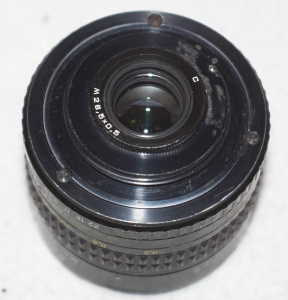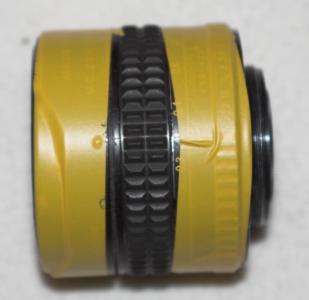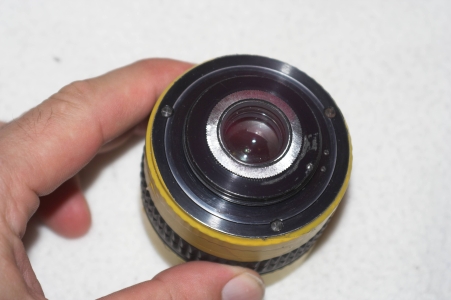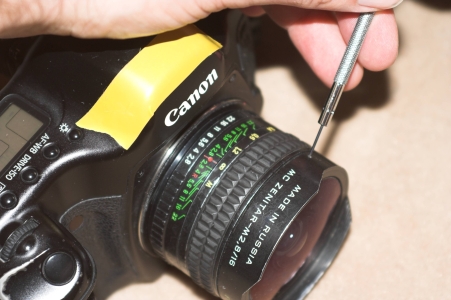Filing the rear filter to get the lens usable on Canon EOS 24x36mm DSLR camera like EOS 5D
With the old M42 screw mount version of the Zenit Zenitar 16mm f/2.8 version of this fisheye lens the big mirror of the Canon EOS 5D DSLR camera hits the mirror. At least with mine.

Years ago I filed the filter ring on the lens - today I would try this without the whole lens.
For filing someting on a lens, it is crucial to get the file chips away from the lens interior. Metal chips inside the lens optical system doesn´t look nice, could cause stray light, or in some cases could probably be visible in the sharp image, or in the bokeh (unsharp areas).
Metal chips could block the iris, or give noise when focusing - or even block the focusing helicoid.
To prevent this I glued a lot of
adhesive tape onto the lens.

I filed down the filter ring metal, very cautios to prevent scratching the lens.

After enough filing, I testes the lens at infinity setting on the camera. Holding the camera in portrait and landscape orientation, looking up and down - mirror hitting depends on orientation! With most lenses it is most critical at infinity.
Lens hood adjustment
Furthermore the lens hood was not correct with the used M42 adapter - this causes shading / vignetting in the edges.
For this I opend screws on the hood, afterwards I could turn the lens hood.

Rear filter needed?
With DSLR cameras
it could be better to take the filter away!
These older lenses are deigned for film still cameras. There is no additional glass between lens and film. With DSLR cameras there are about 2mm glass; At least an IR cut filter, the two anti aliasing filter layers and the sensor cover slip.
The optical correction for the Zenitar 16mm back filter could be nearly perfect for this camera filters - as long as the lens rear filter is removed!
With this flat filter there is too much glass.
But the register distance needs correction for the removed filter.
The lens infinity correction could be be adjusted:
Remove the rubber focusing tape, there are three screws in deep holes. After opening - not removing - these screws, the focus scale could be adjusted.
Here some simple comparison images, for full resolution click in the images.
EOS 5D on small tripod, Zenitar 16mm f/2.8 lens. Filter status and f/stop in filename of image.
Left side image with normal filter, right image without the filter. Here full open at f/2.8 - made for bokeh comparison:


Left side image with normal filter, right image without the filter. Here at f/5.6:


Please visit my other tinker work, or my DIY directory with ~1700 DIY links to other photo tinkering sites.